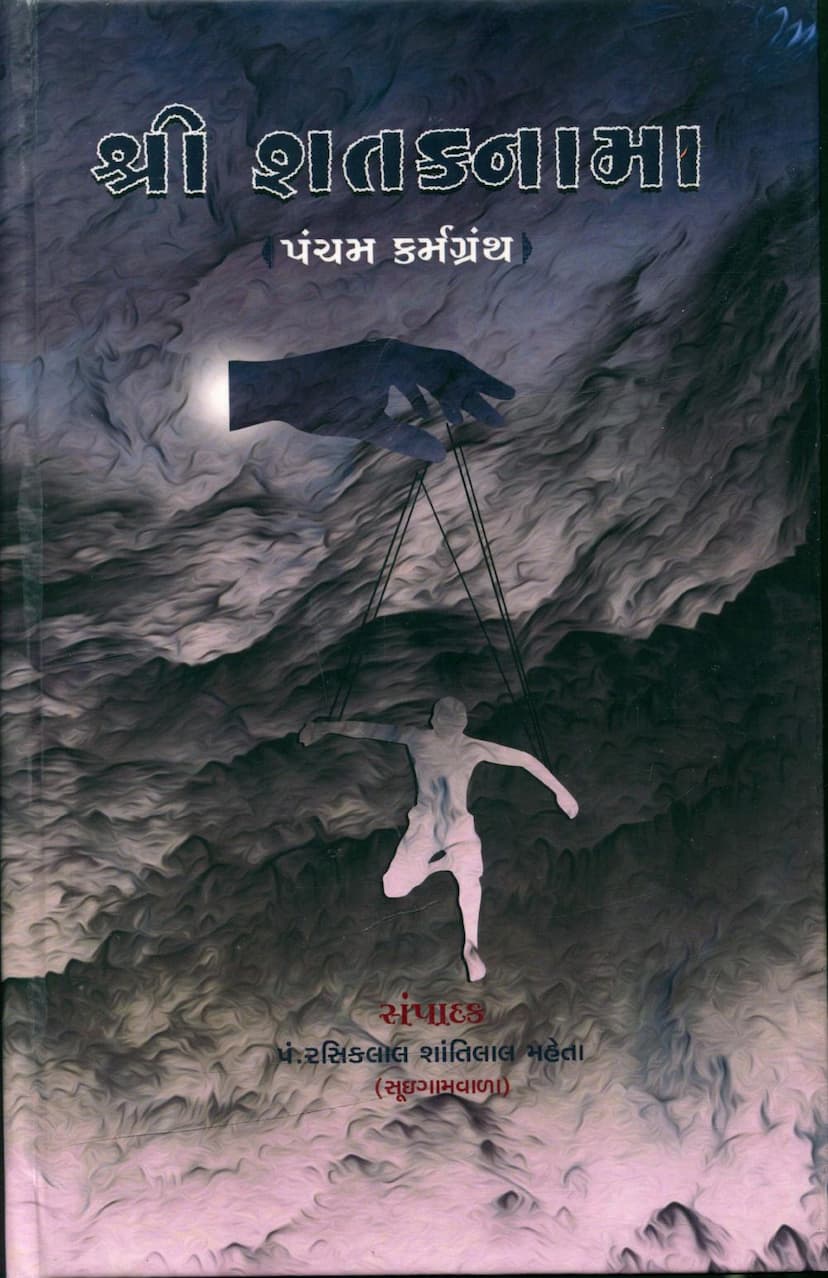Shataknama Pancham Karmgranth
Added to library: September 2, 2025

Summary
Here is a comprehensive summary of the Jain text "Shataknama Pancham Karmgranth" by Rasiklal Shantilal Mehta, based on the provided pages:
Book Title: Shataknama Pancham Karmgranth (The Fifth Karmic Treatise of the Hundred Names) Author: Rasiklal Shantilal Mehta (Edited) Original Author: Acharya Devendrasurishwarji Maharaj Publisher: Agamoddharak Pratishthan
Overall Purpose and Context:
This book is the fifth in a series of five karmic treatises (Karmagranths) composed by Acharya Devendrasurishwarji Maharaj. The series aims to explain the complex doctrine of Karma in Jainism in a simplified and accessible manner, suitable for the intellectual capacity and lifespan of individuals in the current era. This particular volume, "Shataknama" (the Fifth Karmagranth), focuses on the detailed explanation of Prakruti Bandh (the nature of karmic bonds), Sthiti Bandh (the duration of karmic bonds), Ras Bandh (the intensity/flavor of karmic bonds), and Pradesh Bandh (the quantity of karmic matter).
Core Content and Structure:
The text delves into the intricate details of Jain Karma theory, building upon the foundational concepts laid out in earlier karmic treatises. It systematically explains the classification and manifestation of karmic particles (pudgals) based on various principles.
Key Concepts Explained:
The summary of the text highlights the following key concepts and their detailed explanations:
-
The Twenty-Six Doors (Dwaras) of Karma: The text outlines 26 specific aspects or "doors" through which karma is analyzed. These include:
- Dhruva Bandhi (Permanently Bonding) & Adhruva Bandhi (Temporarily Bonding) Karmas: Classifying karmic tendencies based on whether they are always bound or sometimes bound.
- Dhruva Udayi (Permanently Manifesting) & Adhruva Udayi (Temporarily Manifesting) Karmas: Distinguishing between karmas that always ripen and those that manifest intermittently.
- Dhruva Satta (Permanently Existing in the Soul) & Adhruva Satta (Temporarily Existing in the Soul) Karmas: Classifying karmas based on their persistent or transient presence in the soul.
- Ghati (Hindering) & Aghati (Non-hindering) Karmas: Differentiating between karmas that obscure the soul's inherent qualities and those that do not.
- Punya (Meritorious) & Paap (Demeritorious) Karmas: Categorizing karmas based on their auspicious or inauspicious effects.
- Paravartaman (Transitory) & Aparavartaman (Non-transitory) Karmas: Explaining karmas that undergo transformation and those that do not.
- Kshetra Vipaki (Ripening based on space/location), Jiva Vipaki (Ripening based on the living being), Bhava Vipaki (Ripening based on the state of existence), and Pudgala Vipaki (Ripening based on matter): Classifying karmas based on the primary factor that triggers their ripening.
- Prakruti Bandh, Sthiti Bandh, Ras Bandh, Pradesh Bandh: Detailed explanation of how karma binds itself in terms of its nature, duration, intensity, and quantity.
- Bhuyaskar, Alpater, Avashithit, Avaktavya: Further classifications of these four types of bonds, describing increases, decreases, stability, and non-describable aspects.
- Masters of each Bandh (Swami): Identifying which soul-states (Gunasthanas) are responsible for binding these karmas in their gross (utmost) and subtle (least) forms.
- Upasham Shreni & Kshapak Shreni: The paths of subsidence and elimination of karmic particles, respectively, leading towards liberation.
-
Detailed Classification of Karmas: The text elaborates on the 47 Dhruva Bandhi and 73 Adhruva Bandhi karmas, detailing their presence (Satta) and manifestation across the 14 Gunasthanas (stages of spiritual development).
-
Kala (Time) and Bandh (Bonding) Aspects:
- Bhanga (Modes of Karma Bonding): Discusses the four modes of bonding (Anadi-Anant, Anadi-Saant, Saadi-Anant, Saadi-Saant) in relation to different karmic categories and Gunasthanas.
- Sthiti Bandh (Duration of Karma): Explains the maximum and minimum durations for binding each type of karma, and the role of Gunasthanas and passions (Kashayas) in determining these durations. It details the time periods in Palyopam, Sagoropam, and Koti-Sagaropam.
- Abadha Kala (Period of Non-manifestation): Explains the period during which karma remains in the soul without manifesting its effects.
- Ghati Prakruti Classification: Further categorizes karmas into Sarvaghatee (completely hindering) and Deshghatee (partially hindering).
- Yog and Adhyavasaaya (Activity and Mental State): Explains the role of conscious activity (Yog) and mental states (Adhyavasaaya) in bonding karma, and their relative quantities (Alpabahutva).
-
Analysis of Pudgala (Matter) and its Transformation:
- Vargana (Aggregates of Matter): Details the concept of Varganas, the different types of matter aggregates (e.g., Audarik, Vaikriya, Aharak, Taijas, Bhasha, Shwasochhwas, Mano, Kaarmaṇa) that karma particles attach to. It explains the gross (Badar) and subtle (Sukshma) aspects of these aggregates and their relative quantities.
- Pudgala Paravart (Cycle of Matter Transformation): Explains the immense time cycles (Dravya, Kshetra, Kala, Bhava Pudgala Paravart) involved in the transformation of matter by a living being, highlighting the vastness of these processes.
-
Role of Gunasthanas: Throughout the text, the 14 Gunasthanas are referenced to explain when and how certain karmas are bound, their manifestation, persistence, and elimination.
-
Alpabahutva (Relative Quantities): A significant portion of the text is dedicated to explaining the relative quantities (Alpabahutva) of different karmic manifestations, such as the quantity of karma particles, the number of types of karmic manifestations, the duration of karmic effects, and the intensity of passions, across various soul-states and karmic categories.
Key Contributions of this Edition:
- Simple Gujarati Commentary: The editor, Rasiklal Shantilal Mehta, has provided a simple Gujarati commentary to make the profound and complex subject matter accessible.
- Compilation and Organization: The text highlights the effort of compiling and systematically presenting the essence of the original karmic treatises, making it easier for students to grasp.
- Dedication to a Spiritual Cause: The printing of this book was funded by the Sanghavi Rugnathmal Samarthmal Doshi Religious Trust as a part of the spiritual merit gained from a historical initiation ceremony, emphasizing the pious intent behind its publication.
Overall, the Shataknama Pancham Karmgranth is a detailed and systematic exploration of Jain Karma theory, covering the nature of karmic bondage, its duration, intensity, quantity, and the soul's journey through various spiritual stages (Gunasthanas) as it interacts with these karmic forces. The commentary by Rasiklal Shantilal Mehta makes this profound knowledge more accessible to a wider audience.